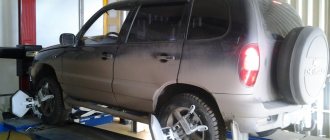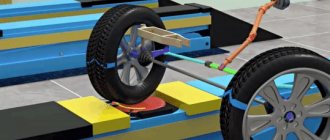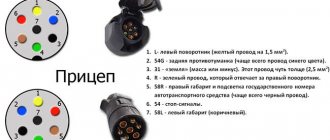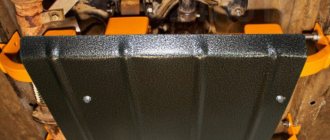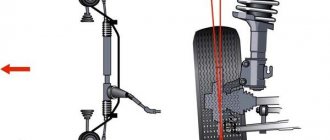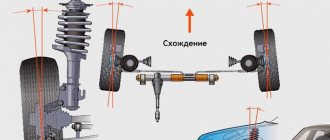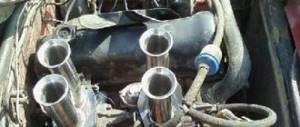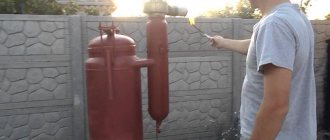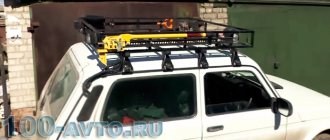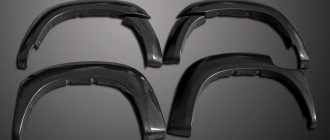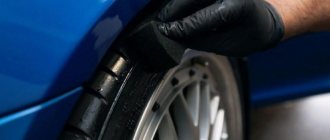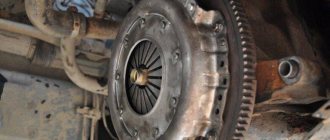What is car wheel alignment?
Wheel alignment or wheel alignment is a procedure that consists of two stages of adjusting the wheels relative to the body: wheel alignment and alignment. These adjustments must be carried out so that there are no problems with the vehicle’s handling, on which traffic safety directly depends.
If the wheels are not adjusted correctly relative to the body, the car will take turns worse and “respond” to steering movements. In addition, without performing wheel alignment in a timely manner, the driver risks encountering the problem of rapid tire wear. In a particularly bad situation, a new tire can wear out in less than 500 kilometers.
Wheel alignment and camber adjustment in modern services is carried out using special stands with optical sensors and diagnostics on a computer. Due to this, it is possible to set the most accurate values. Previously, wheel alignment was adjusted using conventional plumb lines.
What is camber, toe and castor
Despite the fact that the operation is called “wheel alignment,” there is another parameter that greatly affects the controllability of the car. What do these names mean? Camber is the deviation of wheels in a vertical plane. Toe is the deviation in the steering angle of the wheels. Castor - the inclination of the shock absorber strut.
If the camber is done correctly, the contact patch of the wheels with the road is maximum, which provides the best traction and control while driving. If the camber is incorrect, the contact patch of the wheels is reduced, grip and controllability deteriorate, and tire wear also increases. Correct wheel alignment ensures a minimum level of lateral loads while driving, which increases vehicle controllability, reduces driving resistance, and also increases tire life. The correct castor ensures optimal distribution of dynamic loads, making the car more controllable.
What is needed to adjust the wheel alignment
To make your own wheel alignment or camber you will need:
- suspension diagnostics, repair if necessary;
- a special stand, pit tracks, an inspection hole or just a flat area;
- a device for measuring camber and toe angles. If you don't have it, you will need:
- ruler;
- long rail;
- rope;
- masking tape;
- several wooden blocks;
- calipers;
- a set of keys;
- adjusting washers;
- WD-40 liquid;
- jack;
- car repair manual.
What is wheel camber
The term “camber” refers to the angle between the plane of rotation of the wheels and a vertical straight line. In other words, the deviation of the wheels on the axles from the vertical.
Based on the definition of camber, we can conclude that it can be positive and negative:
- Positive camber is called when the upper parts of the wheels on the same axle are at a greater distance from each other than the lower parts. Positive camber is intentionally used on trucks. This is due to the fact that when loading a car with positive camber, the camber can go to zero or get as close as possible to this value;
- Negative camber is called when the upper parts of the wheel on one axle are at a smaller distance from each other than the lower parts. Negative camber is intentionally used to increase vehicle stability when cornering at high speeds.
With zero camber, when the upper and lower parts of the tires are at the same distance along the same axis from each other, it is possible to achieve minimal tire wear.
Camber
- The camber is positive (+) when the wheel is tilted with its upper part outside the car
- Negative camber (—) when the wheel is tilted with its upper part inward of the car
- Zero camber when the wheel is vertical
The camber is adjustable for the front and rear wheels of the car.
Camber is necessary to distribute the vehicle's load evenly across the tire's contact patch at the point of contact to minimize tire wear. Camber can also be used to change a car's handling, sometimes at the expense of tire wear. Negative camber can improve a vehicle's cornering stability by ensuring good tire contact with the road when cornering.
Improper camber can cause wheel slip and excessive tire wear. As a rule, the camber difference on one axle (cross) should be no more than 30′ (in minutes).
Improper camber can lead to the following consequences:
- Tire inner surface wear: - excessive negative camber
- Wear on the outer edge of the tire: - excessive positive camber
- Pulls to one side
- Excessive wheel bearing wear (due to uneven load)
- Poor vehicle handling
Possible causes of incorrect camber:
- Deformation of suspension elements
- Incorrect adjustment
- Incorrect ground clearance
The longitudinal inclination of the kingpin (or axis of rotation) (CASTER) is the angle between the vertical and the projection of a line passing through the centers of the ball joints onto a plane parallel to the longitudinal axis of the vehicle. It helps stabilize the front wheels in the direction of straight motion.
Otherwise, caster is the longitudinal inclination of the wheel's swing plane and can simply be described as a forward or backward MacPherson inclination when looking at the car from the side. Positive caster (+) is when the top support of the strut is moved back. and is more often used on modern cars.
Negative caster is when the top mount of the strut is moved forward. Positive caster provides better directional stability and stabilization than negative caster. If you look at the front wheel and fork of a bicycle, you will see that they form positive caster, and this is what allows you to ride a bicycle without touching the handlebars. The greater the positive caster angle, the heavier the steering wheel.
Since most modern cars are capable of reaching high speeds, a positive caster angle is necessary to ensure high driving stability. Electro-hydraulic steering is designed to overcome heavy steering. As a general rule, the caster on the left and right side of the vehicle should not differ by more than 30′ (in minutes), otherwise the vehicle may pull to one side. The car will pull to the side with the smallest angle.
Incorrect casting can lead to the following consequences:
- Heavy steering - excessive positive caster
- Excessive sensitivity to the perception of road irregularities on the steering wheel - excessive positive caster
- Steering wheel vibration (beating): excessive negative caster force on the steering wheel during left and right turns, one-sided tread wear
- Lack of self-stabilization of the steering wheel -: excessive negative caster, different tire squealing when cornering.
Possible reasons for incorrect caster:
- Upper support - MacPherson strut installed forward or backward
- The trailing arm or its mount moves forward or backward
- The vehicle is not placed on a level surface when making adjustments
- Incorrect vehicle tilt
- Wheels do not lock during adjustment
- Incorrect adjustment (if adjustable)
What is wheel alignment
The concept of “toe-in” refers to the angle between the plane of rotation of the wheels and the longitudinal section of the car. There are positive and negative wheel alignment:
- Toe-in is called positive when the front parts of the wheels are at a smaller distance from each other than the rear parts;
- Toe-in is called negative when the rear parts of the wheels are at a smaller distance from each other than the front parts.
With incorrectly set wheel toe, wheel wear increases significantly, much more significantly than with incorrectly set camber.
What is wheel alignment?
Camber is the angle formed by the vertical and the plane of the wheels. It creates close contact between the tires and the road surface. Properly set angles and toe-in of the wheels guarantee full-fledged operation of the suspension. If they suddenly begin to deviate from normal indicators, this will lead to various problems. For example, the car’s handling will become worse, the load on the CV joints or silent blocks will increase.
Every driver should regularly measure camber and toe angles. But since such operations in a car repair shop cost a lot of money, drivers are looking for ways to save money. They do the work themselves in their garage. Before you begin adjusting the wheel alignment yourself, you need to study the signs of irregularities, as well as instructions for proper operation.
How to determine that your car's wheel alignment is incorrectly adjusted
There are a number of symptoms that clearly indicate that the car’s wheel alignment settings have been disrupted:
- When entering a turn at low speed, you can hear the wheels squealing;
- To move the car in a straight line, the steering wheel must be tilted slightly to the right or slightly to the left from the central axis;
- If you let go of the car's steering wheel, the car begins to spontaneously pull to one side;
- Car tires wear out quickly.
If the symptoms described above appear, it is necessary to adjust the wheel alignment. A similar procedure is performed in almost any service center.
When is it necessary to do a wheel alignment?
The installation angles may be violated, for example, when the ramp hits a curb stone during parking or when driving at high speed onto any defective section of the roadway - a pothole, hole, etc. It is imperative to align the wheel alignment angles even if uneven wear is detected. tires
- The car noticeably “pulls” to the right or left
- The car moves straight only when the steering wheel is turned slightly
- After making a turn, the steering wheel does not return to neutral on its own
After what kind of work is it necessary to do a wheel alignment?
When repairing a car, you need to know in what cases it will be necessary to perform a wheel alignment at the end of the work.
Replacing ball joints
The position of the car's wheels directly depends on the ball joints. After replacing them, it is necessary to perform a wheel alignment. This is due to the fact that in the old ball joint, during operation, play is formed, under which the wheels are aligned. When a new ball joint is installed, play is minimized, accordingly, the inclination of the wheels changes and a wheel alignment procedure is required.
Replacing the steering tip
The toe-in of the wheels depends on the settings of the steering tip. Accordingly, when replacing them, you will need to perform a wheel alignment procedure. It may also be required if the steering rack is being replaced.
Replacing the constant velocity joint (CV joint)
Replacing the CV joint itself does not affect the car's suspension, but after such work it is imperative to carry out a wheel alignment.
This is due to the fact that when replacing a constant velocity joint, specialists unscrew the fastening of the steering tip or ball joint, since this is necessary to remove the CV joint. After replacing, installing a new hinge, when tightening the steering tip, you can lose its settings or even break it, which is why the steering wheel will pull the car to the left or right when driving in a straight line.
What operations can you do yourself?
The only operation that cannot be done correctly on your own is fine adjustment of the castor. If the accident has not changed the geometry of the body, then symptomatic adjustment of the castor can be done. When the car does not listen well to the steering wheel, turns unsteadily and with a delay, you just need to increase the caster for 20–40 minutes. If, during sharp acceleration, the steering wheel begins to be pulled out of your hands, the castor needs to be reduced. It must be remembered that an increase in castor leads to an increase in wheel camber. You can also adjust the wheel alignment yourself. If the body is damaged as a result of an accident, which led to a violation of its geometry, then any adjustment of the suspension is pointless. You will spend a lot of time, and the result will be extremely doubtful. Therefore, after even a minor accident, be sure to check the body geometry on a special stand.
After what work is it not necessary to do a wheel alignment?
Wheel alignment is not a cheap procedure, and often unscrupulous services assure drivers that after carrying out this or that work, it must be done. Below are the most common situations where a driver may feel like they need to perform a wheel alignment, but in reality they don't.
Tire replacement
The most common misconception is that when replacing winter tires with summer tires and vice versa, a wheel alignment is required. This is not so, since replacing tires performed in a standard manner does not affect the toe-in and divergence parameters of the wheels. If, after replacing the tires, the car begins to pull spontaneously to the side when driving in a straight line, you should first check the tires for even wear.
Replacing shock absorbers
We recommend reading: How to bleed shock absorbers before installation
After replacing the shock absorbers, there is no need to perform a wheel alignment, since the steering rods and ball joints practically do not depend on them. When replacing shock absorbers, these steering elements are not affected; they do not even need to be unscrewed.
Replacing stabilizers
The situation with stabilizers is identical to shock absorbers. After replacing them, there is no need to perform a wheel alignment, since the work does not affect the key elements of the suspension and steering.
( 411 votes, average: 4.54 out of 5)
Cylinder head gasket: purpose, signs of breakdown, how to select and replace
Which oil filter is better to choose?
Related Posts
When should adjustments be made?
The adjustment procedure should be completed every year, preferably during seasonal tire replacement. Over the course of a year, the car regularly hits potholes and runs over curbs, which means the chassis becomes loose and the angles begin to change.
In addition to planned adjustments, the procedure can be performed unscheduled. Most often this happens in the following cases:
After a person gets into an accident, which results in a strong impact that damages the suspension components.
After a long journey and forced off-road driving.
After changing the car's clearance.
Adjustment made on time will save the driver from the costs of car repairs and new tires. During the Soviet Union, people did not use computers. They used only a wrench and a caliper to operate the machine. Let's figure out how to adjust the wheel alignment with your own hands in the same way.
